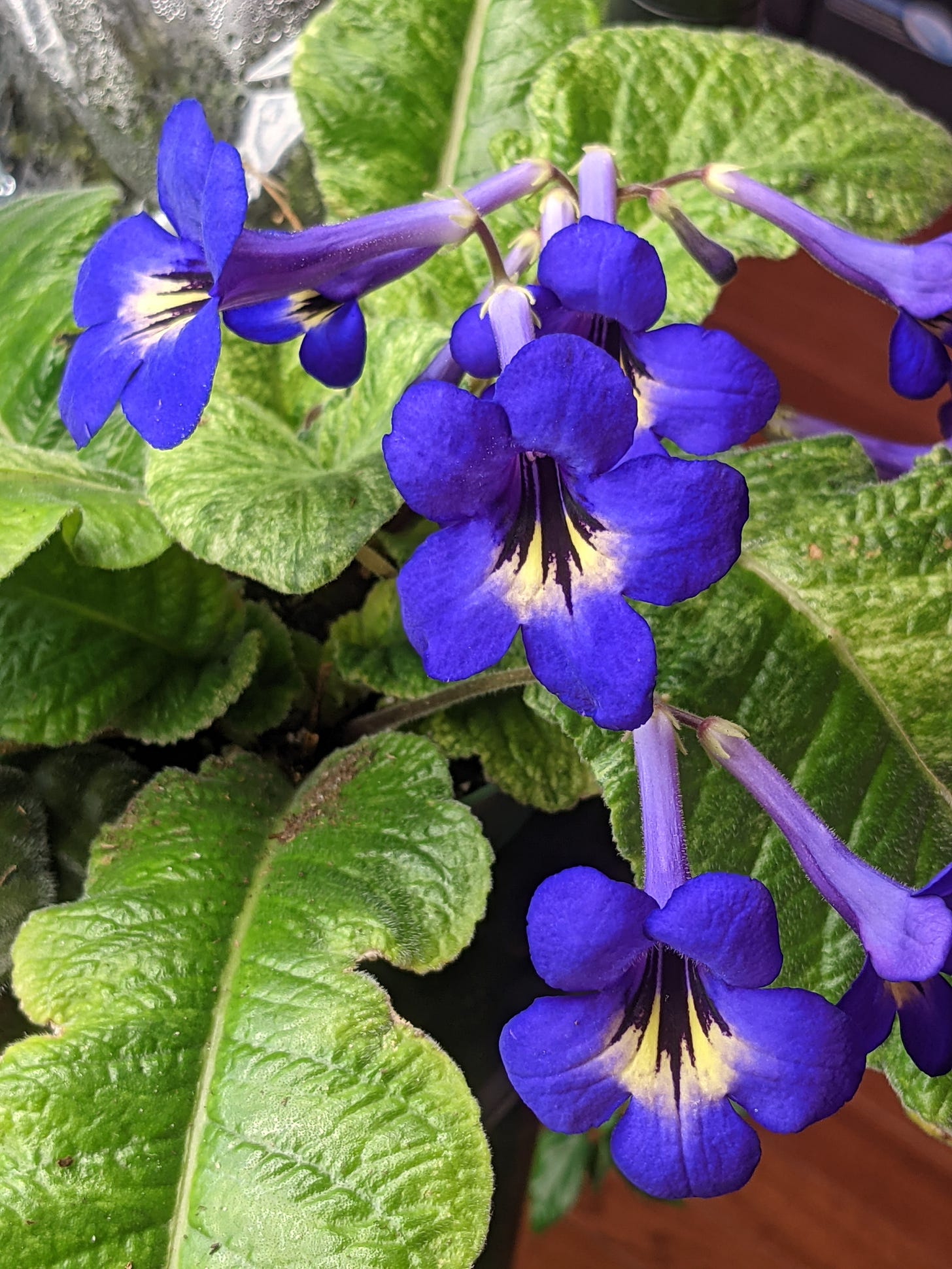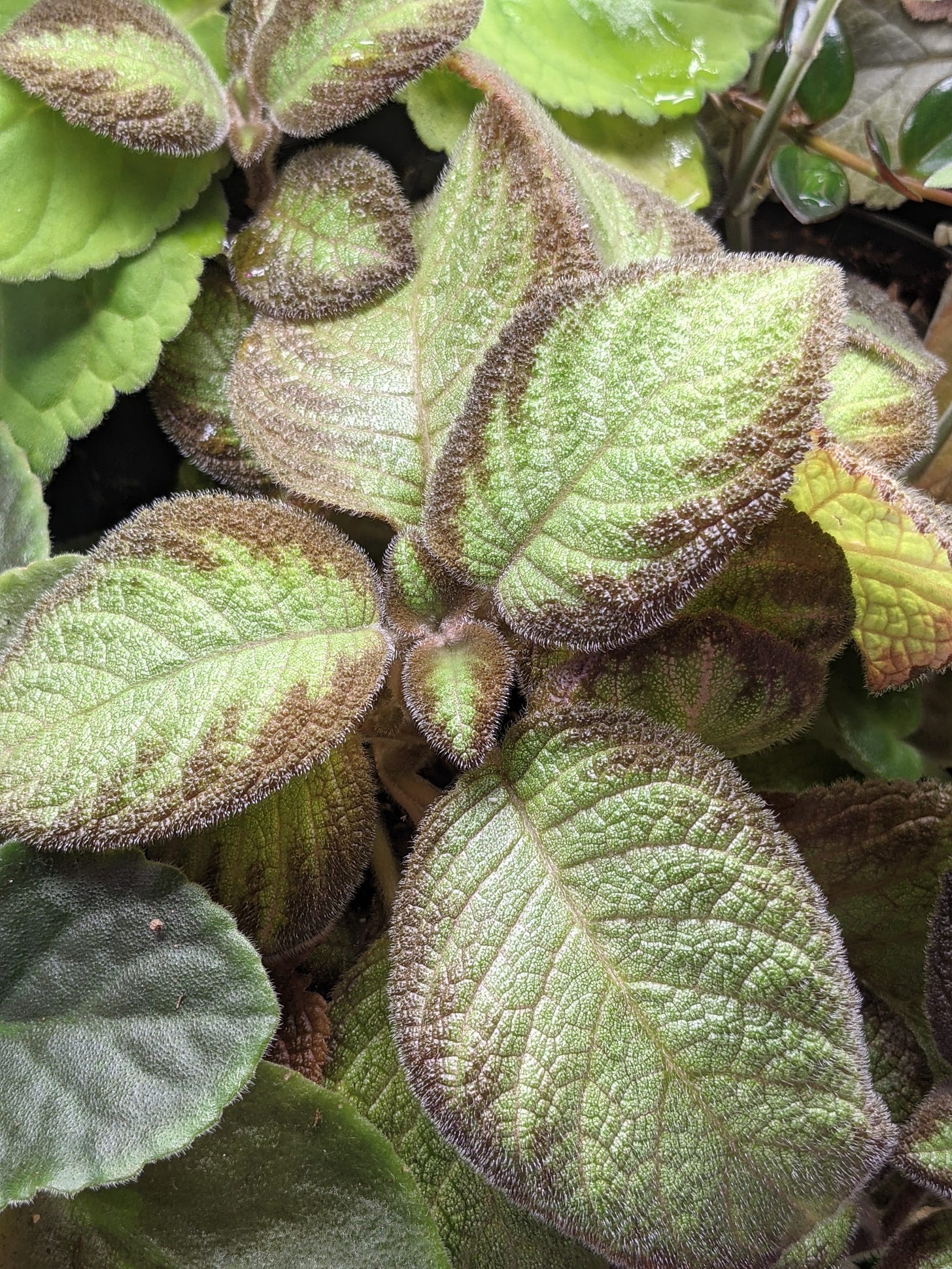The inevitable march towards spring slowed to a crawl this week. We started out Monday barely reaching 40F for a high, and have been struggling since then to get above the low 50s with upper 20s at night, while brisk March winds whipping the landscape make venturing outdoors less than pleasant. Aside from getting the tiller up and running (an adventure in itself) and turning over soil on the north forty, the main action has been indoors.
Thanks largely to abundant seed-starting, late winter and early spring have brought a varied and colorful panorama of gesneriads. The gesneriad family, often described as “African violets and their relatives”, includes many flowering plants excellent for home growing, but which are seldom seen in nurseries, supermarkets and big box stores.
The star of the show for me this spring is Sinningia speciosa a.k.a. the gloxinia, in its varied hybrid forms. Decades ago, a few classics like “Mont Blanc” (white) and Kaiser Wilhelm (deep purple with white fringe) were treasured for their striking trumpet-shaped flowers and large foliage rosettes. These old hybrids used to be commonly found in florist shops but have gone out of fashion. The main reason for gloxinias’ diminished popularity is that they flower for only part of the year, requiring periods of dormancy during which all you’ll see is a bare pot with maybe a bit of tuber protruding above the soil surface. And yet there are few potted plants as spectacular as a well grown gloxinia in full bloom.
The seed strain “Empress” is the one typically available to gardeners through a few seed supply houses and on sites like eBay. Its virtues are compact foliage and dependable flowering in shades of purple, white, red and two bicolors (purple or red with white borders). Another seed mix, which has been difficult to come by in recent times is “Brocade”, featuring double flowers (more on growing gloxinias from seed later in the article).
To branch out further from the “Empress” and “Brocade” hybrid strains in search of alternative colors and especially spotted and speckled petals, you need to look for types sometimes available from specialty growers and the Gesneriad Society. The latter offers members a comprehensive list of seeds not only of gloxinias but of many other gesneriad species and hybrids. This year a number of seed-grown plants from multiple sources have come into flower, considerably broadening my collection.
These and other unnamed varieties came from a batch of mixed hybrid seed. Their leaves are larger and so plants tend to sprawl more than the compact “Empress” types, but I don’t mind making space for these unusual and attractive flowers.
The earliest-grown Gloxinias were the wild type with nodding, “slipper”-type flowers. They’re still available (I have a purple slipper gloxinia) but have largely been supplanted by the upright or peloric forms. Differences are explained here, and the history of how modern gloxinias came to be is discussed in this article. The genus Sinningia also comprises an array of species and hybrids with smaller flowers, of which the tiniest may be Sinningia pusilla, often touted as a terrarium specimen. Years ago my father and I grew one of the pioneering small hybrids, Sinningia “Dollbaby”, a purple slipper-flowered plant that was happy long-term in a three or four-inch pot. Many other such “mini-Sinningias” have been developed. You can get an idea of their variety here. They’re definitely worth seeking out if space is limited or for their intrinsic beauty.
A favorite gesneriad, Rechsteineria cardinalis that was subsequently migrated over to the genus Sinningia by out-of-control botanists, is worth growing for its soft, fuzzy green leaves and bright scarlet tubular flowers. It also forms a tuber and goes dormant for short periods. Similarly-shaped tubular flowers in red-orange characterize Sinningia bulbosa, whose large tuber protrudes well above soil level. It has gotten a reputation of being difficult to bring into bloom, but one of my two plants has been flowering for weeks at a time over late winter and early spring.
Lastly, there’s a mystery tall Sinningia that flowered for me in a previous light garden long ago, producing abundant small tubular orange flowers. It set seed which I dutifully collected and resowed on at least two occasions, with no germination. I decided to give it one more shot a few months ago and lo and behold, tiny plants appeared, which developed oh-so-slowly at first but have now picked up steam to the point where I anticipate flowers by May. Oddly, one plant is producing leaves three at a time in a roughly triangular arrangement around the stem while all the others have alternate leaves. Will this apparent mutation show other differences when it reaches mature flowering size?
The basic requirements of Sinningias are good light (more than African violets need), either under LED or fluorescent lights or in a bright window that gets up to a few hours of sun in the morning or late in the day. Whereas an African violet should do well located about a foot below peripheral edges of a typical two-tube fluorescent shoplight, gloxinias might need to be located 6-8 inches below the center of the fixture. A common problem with florist gloxinias was that people would bring home a plant loaded with buds, most of which would blast and shrivel due to the shock of transitioning to a house or apartment window with low humidity. Maintaining humidity of at least 30-40% is advisable. Home growers are often cautioned not to mist their plants with water for fear of causing the fuzzy leaves to rot - and this well-intentioned advice is extended to African violets and other fuzzy/hairy-leaved plants. In my experience light misting isn’t a problem unless growing conditions are cold and damp. A fine mist from a plastic spray bottle a couple times a day should be beneficial. Sinningias appreciate a well-drained lightweight soil mix the surface of which is allowed to dry out between waterings (soggy soil promotes root and tuber rot). They don’t need a lot of feeding; I water regularly with a quarter-strength or less solution of a relatively high-nitrogen growth fertilizer, transitioning to a feed with a higher middle number once plants approach flowering size. When flowering is over, gradually diminish watering until leaves brown and shrivel, then withhold water. Dormant tubers can be kept in their pots, sprinkled with water on occasion to keep them from shriveling, or they can be removed from the pot and stored in vermiculite or soilless mix moistened with just a few drops of water and kept in a plastic bag. Keep an eye on those tubers; they’ll let you know when it’s time to bring them out for repotting by displaying one or more green shoots. At that point, pot them in fresh soilless mix with about two-thirds of the tuber buried. Water well once, then sparingly until you’re sure the tuber has entered active growth.
Streptocarpus (Latin for “twisted pod”) hybrids have spectacular flowers, such that their absence from stores is something of a mystery. They do prefer brighter light than African violets, akin to the requirements for gloxinias, with the added proviso that household warmth should not be excessive. Temps in the mid to upper 60s are ideal but slightly warmer readings are generally acceptable. The array of flower colors and types rivals that of gloxinias and they are just as easily grown from seed, as these forms demonstrate.
My one named Strep is “Bristol’s Nightfall”, with smaller but vivid blue flowers reminiscent of an old favorite which sadly appears to be defunct in commerce, “Constant Nymph” (if any reader has this one, I’d like to negotiate for a cutting).

Again, the Gesneriad Society and a few online sellers are potential sources for Streptocarpus seeds. Streps can also be propagated through leaf cuttings. In addition to the technique described in the linked article, you can take an entire mid-sized leaf, cutting off and discarding the distal half, and plant the petiole (stalk) in moist potting mix, using a plastic bag or other transparent cover to maintain high humidity. In my experience, rooting is slow no matter how you take the cutting. I have young plantlets finally coming up from leaf cuttings taken 2-3 months ago. These will be be true to type; alternatively you can be adventurous and cross-pollinate Streps (or other gesneriads) to create your own hybrids.
It’s also rewarding to grow your own African violets (formerly Saintpaulia; the genus has regrettably been reclassified under the umbrella of Streptocarpus) from seed. I’ve had good results with seed supplied by this seller, whose mixes include variegated leaf and “fantasy” types. Big seed houses like Park’s used to have African violet seed but those offerings have largely vanished. Look also for specialty society seed lists - membership required.
I have just a couple of “named” African violets which came as plants or were grown from cuttings. One is the aptly-named “Ma’s Crime Scene”, which has maroon-red flowers and variegated foliage. It goes without saying that there’s an enormous selection of African violet hybrids available to fanciers from online sellers (see below for a partial list) in virtually every conceivable color, ranging from minis to sprawling plants best suited for specialty shows. Many of these were hybridized to meet demand for new and different flowers with overall performance under home conditions being a secondary consideration if it was thought of at all. So it’s something of a crapshoot to find consistently good ones. African violet species with smaller but often abundant flowers are worth seeking out. One that’s done well for me is “House of Amani”.
Other gesneriads I grow include Achimenes, Episcia, Columnea, Nematanthus and Aeschynanthus. The most consistently floriferous gesneriad in my collection is Primulina tabacum. The species name comes from the leaves supposedly smelling like tobacco when crushed, but my plant’s foliage is scentless. Not a problem.

There are over 100 genera of gesneriads, many of which have found their way into cultivation and which you’re unlikely to encounter unless you fall into the pleasant trap of becoming a gesneriad fancier. The most popular types tend to share cultivation requirements with Sinningias (see above).
Growing gesneriads from seed may seem daunting at first given seeds’ tiny size (ften described as being like grains of dust, though the dust in my household is usually in the form of tumbleweeds containing a high proportion of shed dog fur). Germinating gesneriad seed really isn’t complicated, especially if you obtain fairly fresh seed. Using a folded sheet of paper or seed envelope, carefully scatter the minute seed over the surface of moist potting mix and cover the pot with a plastic bag or place it in a flat covered by a humidity dome. Don’t sprinkle soil on top of the seed. Provide light. In a few weeks, sometimes a month or two you’ll see tiny green sprouts. After a couple more months plantlets will have two or more pairs of true leaves and can be transplanted to larger community pots or to their own individual small pots. Time from germination to bloom varies but six months is a reasonable expectation for many types.
If you’d rather avoid dealing with seed starting, mature plants and sometimes cuttings are available from online nurseries. Some I’ve dealt successfully with are:
Plant Delights Nursery has intriguing gesneriad selections suitable for outdoor growing in milder climates (surprisingly far north in some cases). Speaking of which, I’ve found some gesneriads adaptable for raising in outdoor borders. They include Gloxinia nemantanthodes "Evita”, a vivid small red-flowered form which makes a great groundcover at the front of the border (dig up the rhizomes before frost in colder areas), Achimenes hybrids and Sinningia tubiflora, a large plant with tubular, slender white or pink flowers which are lightly fragrant and take a surprising amount of cold. I’ve had plants return without protection after winter temps near zero.


















